To Julie Satow ’96, SIPA’01, the Plaza seemed like a personal landmark — a figure always traced into her life’s backdrop.
Columbia College | Columbia University in the City of New York
To Julie Satow ’96, SIPA’01, the Plaza seemed like a personal landmark — a figure always traced into her life’s backdrop.

Julie Satow ’96, SIPA’01
Emily Assiran
Satow became a journalist, writing first about business and then real estate. In 2015, by then a contributor to The New York Times, she decided to write her first book and thought of the mythic hotel she’d known since childhood. The allure of its story was undeniable: The Plaza had been a beguiling, elusive trophy from its earliest days, the kind of real estate prize that had both seduced and frustrated those who possessed it. From the “rakish adventurer” Harry Black, who owned the hotel in the early 20th century, to the Sonnabend family, from Donald Trump to the jailed Indian tycoon Subrata Roy, the Plaza had an almost mystical ability to blind rich investors to the vagaries of its often-tenuous bottom line. Trump, who drove the Plaza into bankruptcy proceedings just four years after he bought it in 1988, called the purchase his “Mona Lisa,” while for the 21st century’s international buyers, the world-famous château was “the ultimate global calling card.”
Satow, for one, didn’t let the romance of the Plaza blind her to its seamier side. The hotel has always been a locus for scams and scandals as well as for opulent refinement; her book, The Plaza: The Secret Life of America’s Most Famous Hotel (Twelve Books, $29), rips open the embroidered Edwardian curtains and pulls up the rugs to reveal the grime. During construction, a retired cop was thrown down two unfinished stories; in the 1970s, Central Park South was known as Prostitutes’ Promenade. Satow’s well-received history is, as The Wall Street Journal puts it, a “lively and entertaining portrait” of a beloved landmark with an “astonishingly unsavory past.”
Satow writes movingly about revisiting the Plaza for a night when she had almost finished her book. She wanders through the hallways, past a boutique, a hair salon and the still-popular portrait of Eloise, to the ornate but empty room where her wedding took place. The building is a hybrid now, part condo and part hotel, with pied-à-terres owned by shell companies on the floors where eccentric widows and their servants used to live. Despite the sometimes awkward alterations, Satow is still moved by the Plaza’s graceful presence — and she’s hopeful about its future. Like any fixer-upper, all it needs is a lot of cash — and the newest owner, Katara (the hotel arm of Qatar’s Investment Authority), clearly has deep pockets. “With sufficient investment,” Satow says, “I am sure the Plaza can return to its former glory.”

“Great hotels have always been social ideas, flawless mirrors to the particular societies they service.”
— Joan Didion
On the morning of October 1, 1907, the hotel bellmen and front desk staff were scurrying about the marble lobby, smoothing their uniforms and making final preparations. Upstairs, maids in starched white aprons checked the sumptuous suites, fluffing feather pillows and straightening the damask curtains. As the hotel manager barked orders, a troop of nervous doormen, dressed in black satin breeches and jackets inlaid with yellow braid, filed outside the Plaza’s bronze revolving door, arraying themselves along the entryway’s red-carpeted steps.
Along Fifty-Ninth Street, crowds had been gathering since the early hours. At 9 a.m., a shiny black carriage finally pulled up in front of the entrance and out stepped Alfred Gwynne Vanderbilt, one of the country’s wealthiest men. The excitement grew palpable as onlookers jostled one another for a glimpse of the New York princeling, while newspapermen called out for a quote. Wearing a top hat and a wide grin, the dashing Vanderbilt strode past the spectators, up the hotel’s grand staircase, and through the revolving door.
Once inside, Vanderbilt headed straight for the front desk. But instead of meeting the clerk, he was confronted by a young Irish girl perched atop the counter, absentmindedly clicking her heels. Mary Doyle was meant to be minding the Plaza newsstand, but while her fellow employees were busily preparing for the grand opening, she had aimlessly wandered over to the desk when she saw the clerk momentarily leave his post. It was at that exact moment that Vanderbilt made his entrance.
“I suddenly realized that the newsstand, where I was supposed to be on duty, wasn’t even in sight from where I sat,” Doyle recalled in her memoir, Life Was Like That. “But, not knowing what else to do, I remained where I was.” As the debonair millionaire looked on bemusedly at the young girl with thick blond hair and a snub nose, there was “a slightly strained moment of silence.” Then, “with a barely perceptible trace of sarcasm,” Vanderbilt inquired if he might not check in. “Still sitting on the desk, I reached out casually, swung the brand-new register pad around in front of him, and dipped and handed him a pen.” Vanderbilt bent over the large book and on the first line of the first page signed, “Mr. and Mrs. Vanderbilt and servant,” forever inscribing himself as the Plaza’s inaugural guest.
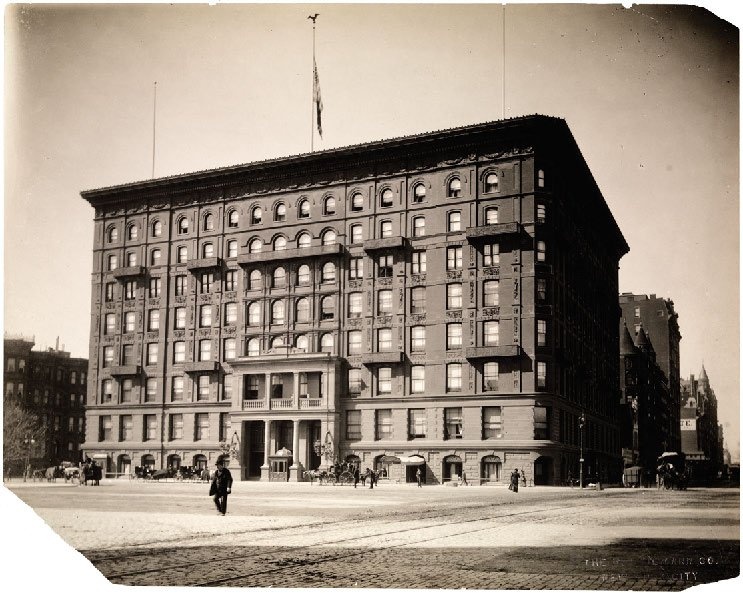
FIRST PLAZA: The first Plaza Hotel was an eight-story structure with a brick-and-brownstone facade, 400 guest rooms and a famous painting of a lion by Massachusetts artist Alexander Pope Jr. It was, for a time, considered one of New York’s grandest hotels. Here it is in 1894.
H.N. Tiemann & Co. / Museum of the City of New York
The Plaza was the most expensive hotel in the city’s history, its looming eighteen stories dominating the surrounding skyline. Its arrival was so monumental that it ushered in new behaviors that would leave their mark on New York for generations.
The Plaza’s opening, for instance, coincided with the debut of one of the city’s most enduring symbols, the modern taxicab. On that first day, those in the crowd who ventured to the Fifth Avenue side of the hotel discovered a fleet of twenty-five bright red cars. These vehicles, imported from France, featured gray interiors with long bench seats and two facing single seats that could be turned up when not in use. The drivers were decked out in matching uniforms made of a similar gray-blue as the interiors. To generate publicity and entice wealthy fans on this first day of business, these prototypes for today’s ubiquitous yellow cabs were being offered free of charge to Plaza guests.
In 1907, cars were still novelties — it would be thirteen more years before the first traffic light graced Fifth Avenue. New Yorkers who didn’t own carriages often depended on two-wheeled hansom cabs to get around town. But these new taximeter cars, with their decidedly faster pace and clearly marked odometers — charging 30 cents for the first half mile and 10 cents for every quarter of a mile after — quickly replaced horse-drawn hansom cabs as popular transport. “The hansom cabbies were curious at first” about the cars, remembered Tom Clifford, a Plaza doorman who was there that first day, “but it was plain to see that trouble was coming.”
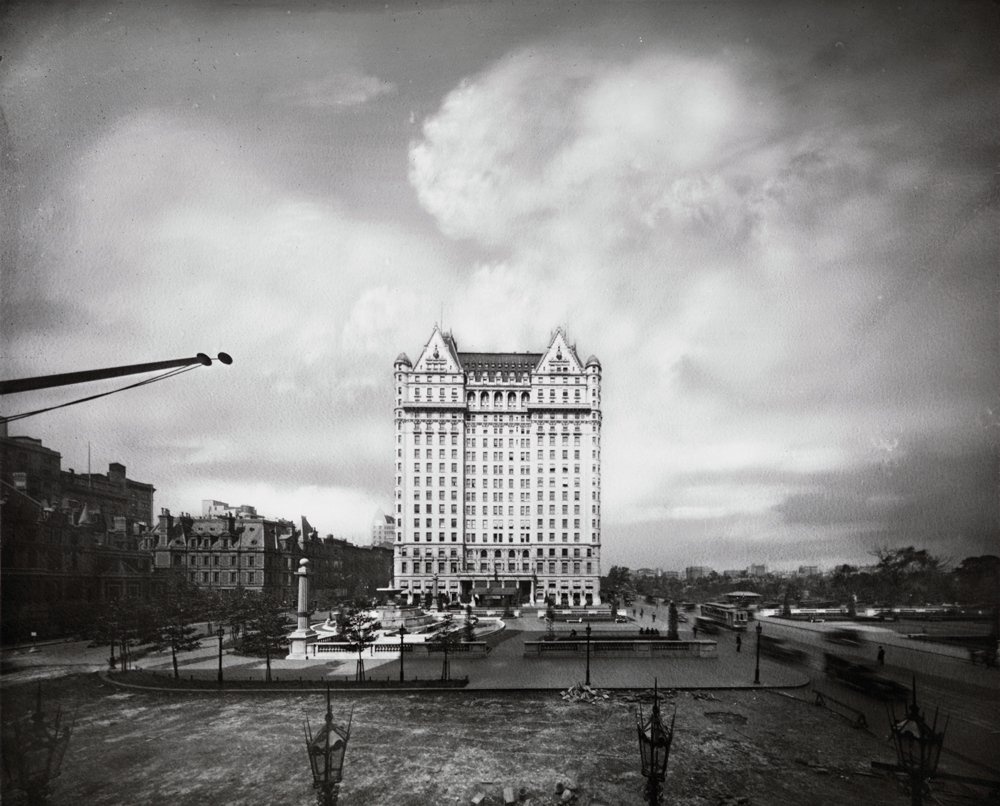
WHITE BEACON: The Plaza was designed as a French château in skyscraper proportions, with a facade of marble and white terracotta, and a copper mansard roof that reflected the green of nearby Central Park. Here it is in 1920, dominating the skyline.
Byron Company (New York, N.Y.) / Museum of the City of New York
The advent of the Plaza ushered in other new behaviors, besides the use of modern taxis. In the wake of the hotel’s opening, for instance, wealthy New Yorkers began embracing a wider public life. Those who had long maintained enormous Manhattan mansions, with their large staffs and expensive upkeep, began moving instead into hotels. The term “hotel” is a bit of a misnomer, since the terms “apartment” and “hotel” were often used interchangeably. Guests like Vanderbilt, Gates, and 90 percent of those who checked in that day were permanent residents with plans to stay indefinitely; some would remain for a lifetime. By living in hotels, these new apartment dwellers avoided what was dubbed the “servant problem,” or finding and keeping affordable, well-trained help. The New York Times marveled at “the large number of suites to be occupied by people who have hitherto had their own private residences.”
There was also the draw of the Plaza’s unsurpassable modern amenities. Guests could order exotic dishes like turtle soup and enjoy the ease of such conveniences as thermostats, telephones, and automatically winding clocks. “Certainly, no private house, however expensively equipped can, as yet, show the appliances for making life not only comfortable and easy, but also hygienic,” the fashion magazine Vogue wrote in an early review of the hotel. Guests didn’t have to hire decorators, as every one of the Plaza’s eight hundred rooms came replete with the most elegant of furnishings, including dark wood armoires and sofas upholstered in rich brocade. There were three-button panels that allowed guests to call for a bellboy, maid, or waiter, who were stationed on every floor. And room service was delivered through an elaborate system of pneumatic tubes and dumbwaiters, so it would arrive still warm from the cavernous kitchens below.
Of course, not every guest appreciated the modern conveniences. When the famed tenor Enrico Caruso first moved into his suite at the Plaza, the loud ticking emanating from the automatic clock in his room interrupted his vocal training. In a fit of pique, he put the annoyance out of commission with a blow. But he failed to realize that each clock was connected to a master clock, and the destruction of one machine ruptured the entire system. Sleepy guests who awoke “to glance at the room clock, discover[ed] that the day evidently was standing still,” noted a dispatch in the Baltimore Sun. “Those who had luncheon engagements were assailed by ennui as they waited for the hour that came not.”
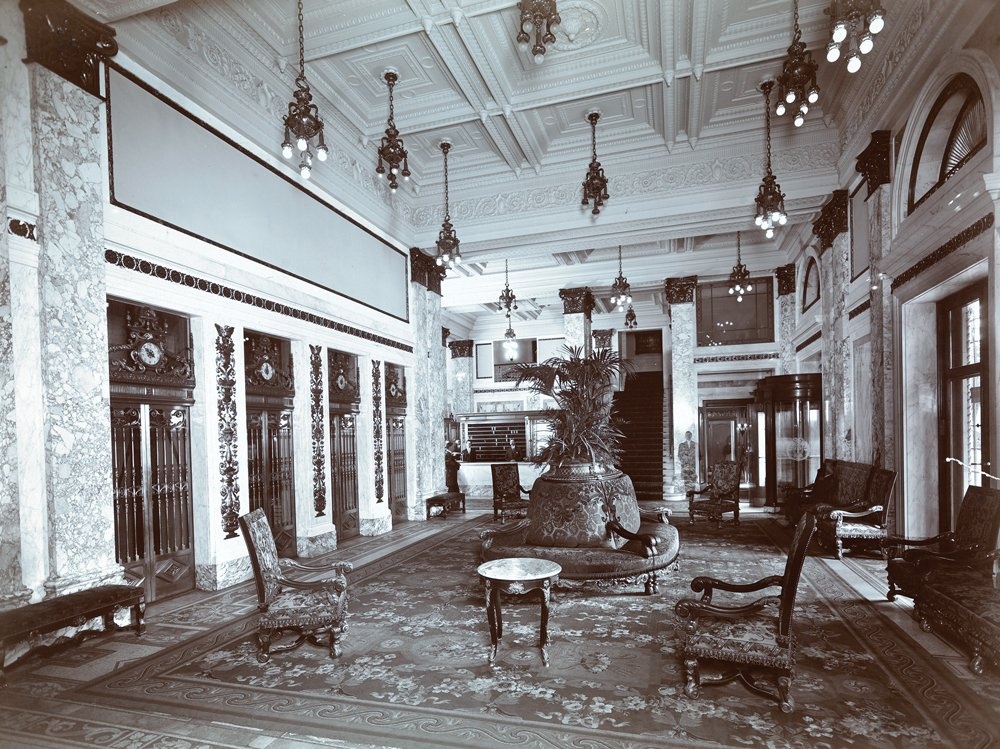
PLUNGERS: The Plaza was sumptuously outfitted with lavish furnishings in brocades of rose and green, more than 1,000 crystal chandeliers and elevators featuring glass doors through which the mechanical pistons could be seen. Called “plungers,” these elevators were a technological feat, and remained in use well into the 1970s. Here, the lobby on opening day in 1907.
Byron Company (New York, N.Y.) / Museum of the City of New York
The opening of the Plaza also influenced fashion and social patterns. Since the 1890s, the elite of society had paraded their finery along Peacock Alley, a three-hundred-foot marble corridor that ran the length of the fashionable Waldorf-Astoria hotel. It was a grand spectacle that epitomized the excesses of the Gilded Age. But now, with the Plaza, this behavior became a broader phenomenon. It became popular to go out to restaurants and eat among strangers, and to spend evenings ballroom dancing to an orchestra with hundreds of other couples. The Plaza and its compatriots became preeminent places to show off, enjoy one’s wealth, and cement one’s status in high society. At the Plaza, you could march through the lobby in the latest fashion and be assured of appearing in the society column, the hotel hallways being clogged with reporters in search of gossip to fill the next day’s papers.
The Plaza also offered new levels of celebrity, a precursor to reality stars like the Kardashians. For instance, when one of New York’s wealthiest society matrons, Mrs. Stuyvesant Fish, arrived at the Plaza one evening dressed in a broadtail fur cloak fastened with a conspicuous diamond brooch on the outside of her coat, it caused a flurry of copycats. “In a flash this innovation had sunk deep into the hearts of other women,” detailed one columnist, in a piece titled “Jewels Outside Your Furs.”
Even those with less wealth could successfully leverage the publicity offered by a hotel. As one reporter archly noted, all you had to do was host a relatively inexpensive party, “amounting to no more than afternoon tea,” and you would find yourself the exalted subject of an item such as: “Mrs. So-and-So entertained 50 guests at luncheon at the Plaza Hotel, the company afterwards playing bridge.”
And long before the Beatles drew frenzied fans to the Plaza, highly anticipated celebrity sightings were attracting crowds. A year after the Plaza opened, word leaked out that Miss Gladys Vanderbilt, sister of Alfred Gwynne Vanderbilt, and her betrothed, the Count Laszlo Szechenyi, would be having tea at the Plaza’s Palm Court. They were to arrive at the same time as Miss Theodora Shonts and her fiancé, the Duc de Chaulnes, and the public, anxious to catch a glimpse of the titled royalty, began swarming the hotel.
“Within half an hour the corridors were impassible. Visitors took possession of bellboys’ benches and every available chair,” noted the New York Times. The hotel closed the Palm Court’s glass doors against the throngs, but “the crowd was undismayed and courteously stormed” the room, forcing the maître d’hôtel to use his “broad shoulders” to “resist the advances of a flying wedge of well-dressed women.” In the end, when the famous guests arrived, one couple was surreptitiously escorted to their table by way of the hotel’s ground-floor pantry, while the other snuck in through a lobby brokerage office.
Another draw of hotel life was the dining. It was from hotels that Parker House rolls, Waldorf salad, and the Manhattan cocktail originated. The Plaza’s popular subterranean Grill Room, located beneath the lobby, featured a glass refrigerator from which patrons could pick their own steak or pork chop. As an added bonus, the restaurant unexpectedly offered ice-skating during the warm summer months. As June rolled around, the hotel flooded the Grill Room’s tile floor with water they then froze, so that customers could while away the time between courses skating, a full orchestra dressed in white tuxedos providing the musical accompaniment.
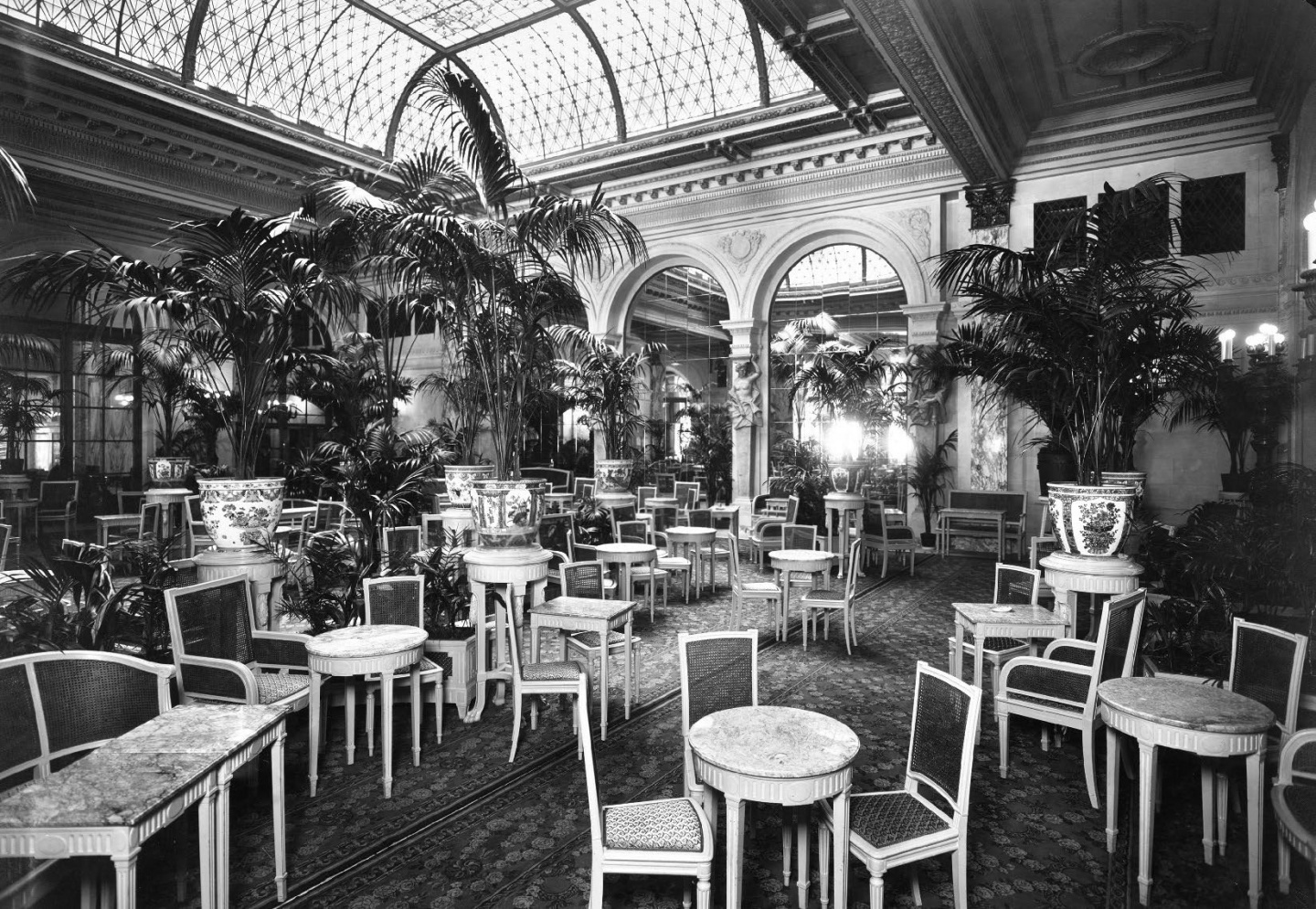
TEA TIME: The tea room, later named the Palm Court, featured a curved ceiling made of colored glass that let in daylight, and oversized palm trees and rubber plants, lending the room a garden-like ambience. It was here that British actress Mrs. Patrick Campbell scandalized patrician patrons by lighting up a cigarette shortly after the hotel’s opening.
Byron Company (New York, N.Y.) / Museum of the City of New York
“Like their owners, Plaza dogs tend to be exceptionally well dressed and well fed. They find life at the hotel unhurried and pleasant,” the magazine noted. There was Nana, a French poodle who boasted her own room featuring a miniature bath, a dog tutor, a dog nurse, and, of course, a specially designed dog-food menu. There was also Pelleas, a chic Pekingese owned by a famous Belgian author; and Bonzu, who at thirteen was the hotel’s oldest canine inhabitant. Given the wealth of its residents and the life of ease many enjoyed, it made sense that the Plaza was known for its dogs. As Thorstein Veblen, the economist who coined the phrase “conspicuous consumption,” noted, the dog, unlike the mouse-chasing cat, “commonly serves no industrial purpose.” A dog is merely “an item of expense,” its “unquestioning subservience and a slave’s quickness in guessing his master’s mood” making it an ideal showpiece for the rich.
Not all dogs, however, were showpieces. A tiny Pomeranian named Digi would prove Veblen wrong when he accomplished what even a New York City police detective could not. Digi’s mistress, Patricia Burke, a socialite visiting from Los Angeles, had lost a diamond-and-pearl ring somewhere in the vast reaches of the hotel. Employees were dispatched to look for it, and a detective was called. But it wasn’t until Digi, who had been following his mistress about the hotel all day, began making strange noises that she finally paid him some heed.
“Miss Burke looked at Digi, and there, to her amazement, was the ring gripped tightly in the teeth of the Pomeranian,” reported the Washington Post. Another useful dog was Captain, a bulldog who belonged to Plaza resident Mrs. Benjamin Kirkland. Every evening, Captain appeared at the front desk to collect a leather case filled with valuable jewels, which he would then carry — “never did anyone touch the bag in the Boston bull’s mouth” — to Kirkland’s room in time for her to dress, according to one retelling.
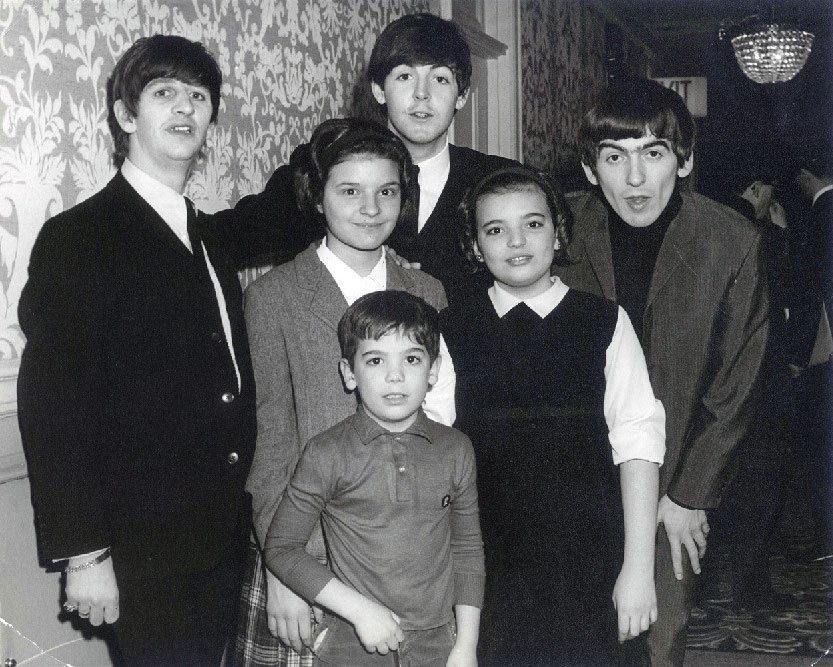
McCARTNEY MOMENT: While countless young fans tried to sneak up the Plaza’s back staircase into the Beatles’s 12th-floor suite, Gregg Salomone, whose father managed the hotel, strolled through the front door of the musicians’ rooms. Here, a 6-year-old Gregg stands with Ringo, Paul and George, as well as his sister Lourdes and her friend Bunny Castalano. Gregg’s hand is hovering because moments earlier, Paul had pointed out that his fly was open.
Courtesy Gregg Salomone
Even the Plaza’s air was rarefied. The hotel used an elaborate ventilation system to purify the oxygen pumped into the building, and a network of thermostats ensured “there is no annoyance with furnaces that will not burn, with steam radiators that refuse to be hot, or that persistently compel us to endure either a tropical heat or dangerous draughts from windows opened in despair,” Vogue wrote approvingly. The refrigeration equipment was also a modern wonder, used not only to produce ice for tea and cocktails, but to circulate brine all the way up to the hotel’s seventeenth floor, above the guest rooms. There, it was used to cool a storage room for guests’ fur coats.
From the book THE PLAZA: The Secret Life of America’s Most Famous Hotel. Copyright (c) 2019 by Julie Satow. Reprinted by permission of Twelve/Hachette Book Group, New York, NY. All rights reserved.

Published three times a year by Columbia College for alumni, students, faculty, parents and friends.
Columbia Alumni Center
622 W. 113th St., MC 4530, 6th Fl.
New York, NY 10025
212-851-7852
cct@columbia.edu

Columbia Alumni Center
622 W. 113th St., MC 4530, 4th Fl.
New York, NY 10025
212-851-7488
ccalumni@columbia.edu